Trying to decide between the 28 Nosler and 300 Win Mag cartridges? Here’s what you need to know about them.
I think most hunters would agree that the 300 Winchester Magnum and 28 Nosler both fantastic cartridges for certain situations. However, while there is definitely some overlap in their capabilities, there are some major differences between the 28 Nosler vs 300 Win Mag cartridges you should be aware of.
Unfortunately, as is the case with many things involving somewhat high octane, new cartridges like the 28 Nosler, there’s a lot of misinformation and marketing hype out there regarding the capabilities of the new caliber. For this reason, while they’re both among the best cartridges for hunting many species of game these days, it’s really easy to get confused when trying to understand the actual strengths and weaknesses of that cartridge compared to more established centerfire rifle cartridges like the 300 Winchester Magnum.
In this article, I’m going to investigate the 28 Nosler vs 300 Win Mag debate in detail and provide some insight into which cartridge is better suited for common hunting situations so you can make an informed decision on which one will work best for your individual needs as a hunter or shooter.
Before we get started, I have an administrative note for you.
Some of the links below are affiliate links. This means I will earn a small commission (at no extra cost to you) if you make a purchase. This helps support the blog and allows me to continue to create free content that’s useful to hunters like yourself. Thanks for your support.
Additionally, I recorded an entire podcast episode on this exact subject. If you’d rather listen than read, click the appropriate link below to listen to this episode on your preferred podcasting service.
28 Nosler vs 300 Win Mag Podcast
Apple | Google | iHeart | Pandora | Spotify
History Of The 28 Nosler and 300 Win Mag
The United States entered a period of sustained economic growth after the end of World War II in 1945 and the manufacturing base that produced gigantic quantities of weapons for use during the war switched over to firearm and ammunition development for civilian use.
For these reasons, those next couple of decades were a true renaissance of civilian firearm and cartridge development in the United States. That time period saw a flood of new centerfire rifle cartridges like the .223 Remington, .243 Winchester, .280 Remington, and .308 Winchester.
That same general time period also saw the start of modern “Magnum Era” when Winchester introduced a line of new belted magnum cartridges that utilized a modified .375 H&H Magnum case. The big bore .458 Winchester Magnum came along first in 1956. Winchester followed up with the release of the .338 Winchester Magnum and the .264 Winchester Magnum during the next couple of years.
All three of those cartridges utilized a .375 H&H Magnum case necked down (or up, in the case of the .458 Win Mag) and shortened from 2.85″ to 2.5″ long. Designers used those shortened cases so all three cartridges would fit in a standard length rifle action (same as the .30-06 and 270) instead of the longer magnum length action required by the original .375 H&H cartridge.
Those cartridges were all commercially successful, but Winchester didn’t stop with the .264, .338, and .458 Win Mag cartridges.
Remington sent shockwaves through the hunting and shooting worlds with the introduction of the 7mm Remington Magnum in 1962. That cartridge also used a shortened and necked down .375 H&H case and fired a 7mm/.284″ bullet. The new high velocity 7 mm Remington Magnum cartridge was a massive commercial success and quickly began to take market share away from the .264 Winchester Magnum.
Winchester responded with the introduction of the .300 Winchester Magnum (also known as the .300 Win Mag or .300 WM) the following year in 1963.
Built using a modified .338 Winchester Magnum case necked down to use a .30 caliber bullet, the .300 Winchester Magnum basically duplicated the performance of the other fast .30 caliber cartridges of the day like the .308 Norma and .300 H&H Magnum.
Unlike those other .30 caliber magnums though, the .300 Win Mag utilized a shorter case that fit in a standard length rifle action like the other new Winchester belted magnums as well as the 7mm Remington Magnum.
Offering a dramatic improvement in performance over the venerable .30-06 Springfield that also compared favorably to the 7mm Rem Mag in many areas, the .300 Win Mag was an almost instant commercial success for Winchester.
If you’d like to learn more about how the 7mm Rem Mag compares to the 300 Win Mag in more detail, read the article below:
7mm Rem Mag vs 300 Win Mag: What You Know May Be Wrong
In fact, the 7mm Remington Magnum and the 300 Winchester Magnum are both among the most popular centerfire rifle cartridges in the United States to this day.
However, there’s another heavy hitting magnum cartridge really sticks out from the crowd: the 28 Nosler.
Nosler initially made a name for itself in the hunting community by developing revolutionary hunting bullets like the Nosler Partition, Nosler AccuBond, Nosler Expansion Tip (E-Tip), and Nosler Ballistic Tip.
Well, Nosler dove headfirst into the cartridge development world with the introduction of the new 26 Nosler cartridge in 2013.
The name “26 Nosler” reflects both the name of the company as well as the first two digits of the cartridge bullet diameter (.264″ in the case of the 26 Nosler cartridge).
Based on a slightly modified 404 Jeffery case necked down to shoot .264″ bullets, the 26 Nosler was definitely in the running for the title of the “world’s most powerful 6.5mm commercial cartridge.”
The 26 Nosler was a big enough commercial success that Nosler introduced the 28 Nosler, which fires 7mm/.284″ bullets, as the next addition to their line of Nosler Proprietary Cartridges in 2015.
Like the 26 Nosler, the 28 Nosler also uses a modified 404 Jeffery case that’s necked down and shortened to fit in a standard 30-06 length action. They decided to use a 1:9 rifling twist rate for the 28 Nosler that’s optimal for long, high BC 7mm/.284″ bullets like their 175gr AccuBond Long Range bullet.
The result is a cartridge capable of launching those heavy for caliber and extremely aerodynamic bullets at muzzle velocities in excess of 3,100fps. The cartridge is also capable of firing lighter 140gr, 150gr, and 160gr bullets approximately 200-300fps faster than the old 7mm Rem Mag.
Not surprisingly, the flat shooting and hard hitting 28 Nosler is a favorite among hunters after big game like elk who want a cartridge that offers excellent performance at extended range.
The success of the 26 and 28 Nosler spurred the development of further Nosler cartridges. As of 2022, the lineup of Nosler cartridges also includes the 22 Nosler (.224″ caliber) introduced in 2017, the 27 Nosler (.277″ caliber) introduced in 2020, the 30 Nosler (.308″ caliber) introduced in 2016, and the 33 Nosler (.338″ caliber) introduced in 2016.
Of all those, the 28 Nosler is by far the most popular as I write this article.
If you’d like to learn more about how the 28 Nosler compares to the 7mm Rem Mag in more detail, read the article below:
7mm Rem Mag vs 28 Nolser vs 6.8 Western Review & Comparison
28 Nosler and 300 Winchester Magnum Cartridge Sizes
You can see the similarities and differences between the 28 Nosler and 300 Winchester Magnum in the photos below.
First, though the 300 Win Mag has a slightly longer case (2.62″ vs 2.59″), the 28 Nosler and 300 Win Mag both have the same overall length of 3.34″ (same as the 30-06).
Both cartridges are designed for use in a long or standard length action.
While both cartridges have slightly different rim diameters (.532″ for the 300 Win Mag vs .534″ for the 28 Nosler), they both use a larger diameter cartridge case and require a larger magnum bolt face. The 28 Nosler also has a rebated rim while the 300 Win Mag does not.
Since they’re descended from different cartridges (the 375 H&H belted magnum for the 300 Win Mag and the beltless 404 Jeffrey for the 28 Nosler), the 300 Winchester Magnum uses a belted case while the 28 Nosler has a beltless case.
Furthermore, it’s important to note that the actual case diameter of the 28 Nosler (.55″) is larger than the non-belted portion of the 300 Win Mag case (.513″).
Additionally, the 300 Winchester Magnum has a 25 degree shoulder angle while the 28 Nosler has a steeper 35 degree shoulder angle.
For all those reasons, the giant 28 Nosler case has a slightly larger case capacity and can hold more powder than the 300 Winchester Magnum.
The 28 Nosler is also loaded to a slightly higher pressure than the 300 Win Mag (65,000psi vs 64,000psi).
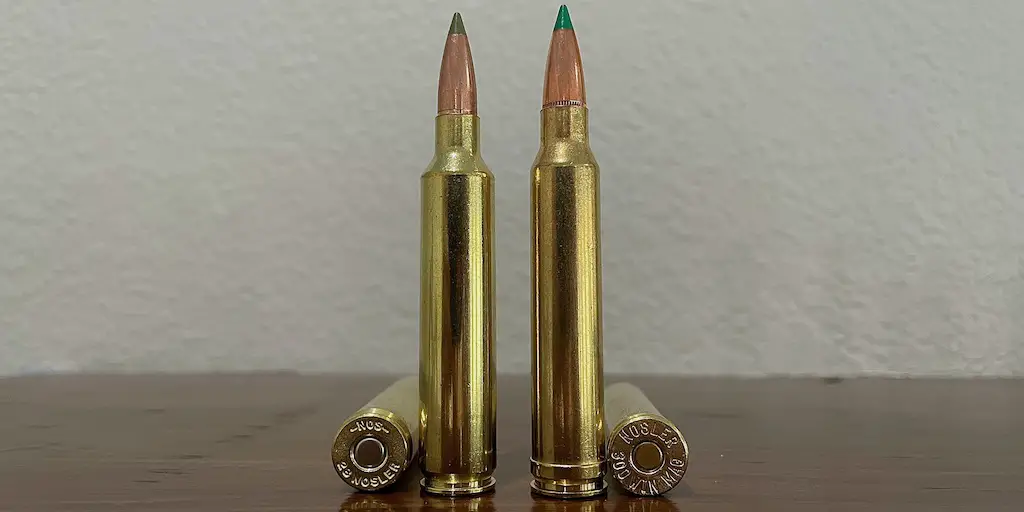
Bullet size is another one of the other important differences between the 28 Nosler vs 300 Win Mag. The 28 Nosler uses .284″ diameter bullets while the 300 Win Mag uses larger .308″ bullets.
Everything else being equal, the smaller diameter 7mm bullets the 28 Nosler uses have a higher ballistic coefficient and a higher sectional density than the larger diameter bullets of the same weight from the .300 Winchester Magnum.
However, the .300 Winchester Magnum generally uses heavier bullets than the 28 Nosler.
For instance, the 28 Nosler most often uses bullets in the 150-185gr range in factory loads. 150gr, 155gr, 160gr, 162gr, and 175gr bullets are the most common for that cartridge.
On the other hand, the 300 Win Mag commonly uses bullets in the 150-220 grain range with 150 grain, 165 grain, 180 grain, 190 grain, and 200 grain bullets being most common.
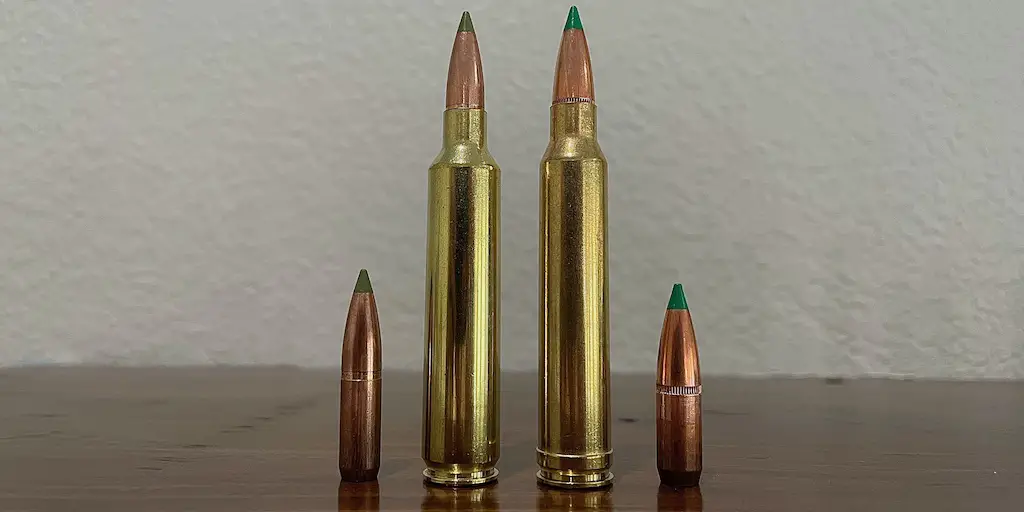
Sectional density is a measure of the ratio of the diameter of a projectile to its mass. All other things equal, a heavier projectile of a given caliber will be longer and therefore have a higher sectional density and consequently penetrate deeper than projectiles with a lower mass and sectional density.
As an example, 150 grain and 175 grain .284″ bullets have sectional densities of .266 and .310 respectively. This compares favorably to 150 grain and 180 grain .308″ bullets which have sectional densities of .226 and .271 respectively.
At the same time, while the 28 Nosler tops out with 175 grain bullets, the .300 Win Mag is capable of firing 200 grain, 208 grain, and 220 grain bullets with sectional densities of .301, .313, and .331 respectively.
The exact details vary (and we’ll get into this in a minute), but the heaviest and most aerodynamic bullets commonly used by the 28 Nosler have a higher BC than the most aerodynamic bullets commonly used by the 300 Win Mag.
A good example here is the .284″ 175 grain Nosler AccuBond Long Range. That bullet has a G1 BC of .648, which outclasses the .30 caliber 190 grain Nosler AccuBond Long Range & .30 caliber 200 grain Hornady ELD-X (both have a G1 BC of .597) as well as the .30 caliber 200 grain Federal Terminal Ascent (G1 BC of .608).
Furthermore, the gigantic case capacity of the 28 Nosler allows the cartridge to fling those very heavy, high BC bullets at a very fast muzzle velocity, which translates into a flatter trajectory, less wind deflection, and more energy retained at longer range.
We’ll get into details of how all this translates into real world performance here shortly.
Note: while the powder capacity figures listed below do give a good indication of the differences between the two cartridges, exact case capacities vary slightly according to the brand of brass used.
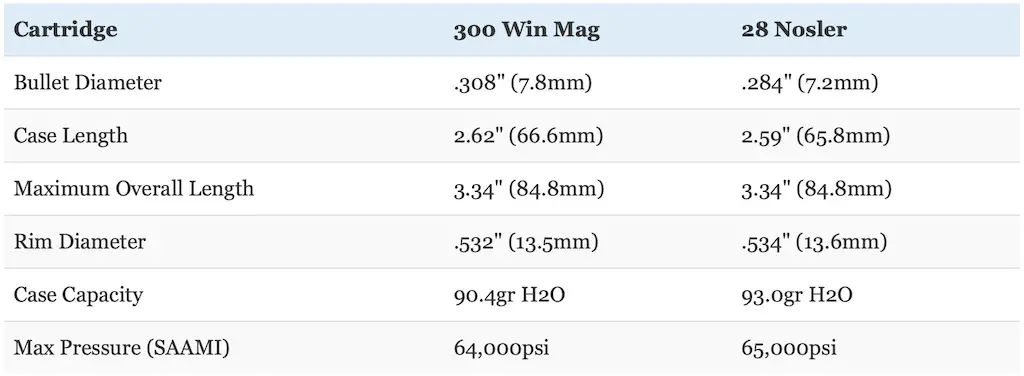
28 Nosler vs 300 Win Mag Ballistics
As you can probably imagine, the differences in the external dimensions of these cartridges also translate into some important differences in their ballistic performance. This is illustrated in the table below comparing several different varieties of 28 Nosler and 300 Win Mag factory ammunition.
Specifically, the 28 Nosler loads use 155gr Terminal Ascent (.586 BC), 160gr Partition (.475 BC) and 175gr AccuBond Long Range (.648 BC) bullets.
The 300 Win Mag loads use 165gr CX (.440 BC), 190gr AccuBond Long Range (.597 BC), 200gr Partition (.481 BC), and 200gr Terminal Ascent (.608 BC) bullets.
The Nosler AccuBond Long Range loads use heavy for caliber, very high BC bullets for each cartridge and the Partition loads use heavy for caliber, very tough bullets with a lower BC for each cartridge.
The situation is a little different with the Terminal Ascent loads though. The 300 Win Mag Terminal Ascent load uses a very heavy, high BC bullet, while the 28 Nosler Terminal Ascent load uses a relatively lighter for caliber (but still pretty high BC) bullet.
Interestingly, that particular 28 Nosler Terminal Ascent loading is the flattest shooting 28 Nosler factory load currently available. It also uses one of the lightest bullet weights available in a factory load for that cartridge (Nosler makes a 150gr E-Tip load that’s a tiny bit lighter, and almost as flat shooting).
With that in mind, I decided to add the 300 Win Mag Hornady Superformance loading to the comparison. Firing a 165gr CX bullet at a blazing fast 3,260fps, that particular loading is the flattest shooting 300 Win Mag factory loading I could find and I included it in order to compare the flattest shooting loads for each cartridge.
And before you ask, no, the 28 Nosler is not currently available in Hornady’s Superformance line, otherwise I would have included it below.
This whole comparison is a little different than most of my other cartridge comparisons because of the limited bullet offerings available for the 28 Nosler. This made it a little more difficult to do an “apples to apples” comparison for both cartridges, but I think those 7 loads are a pretty good representation of the performance of the 28 Nosler and 300 Win Mag.
All seven loads used a 200 yard zero.
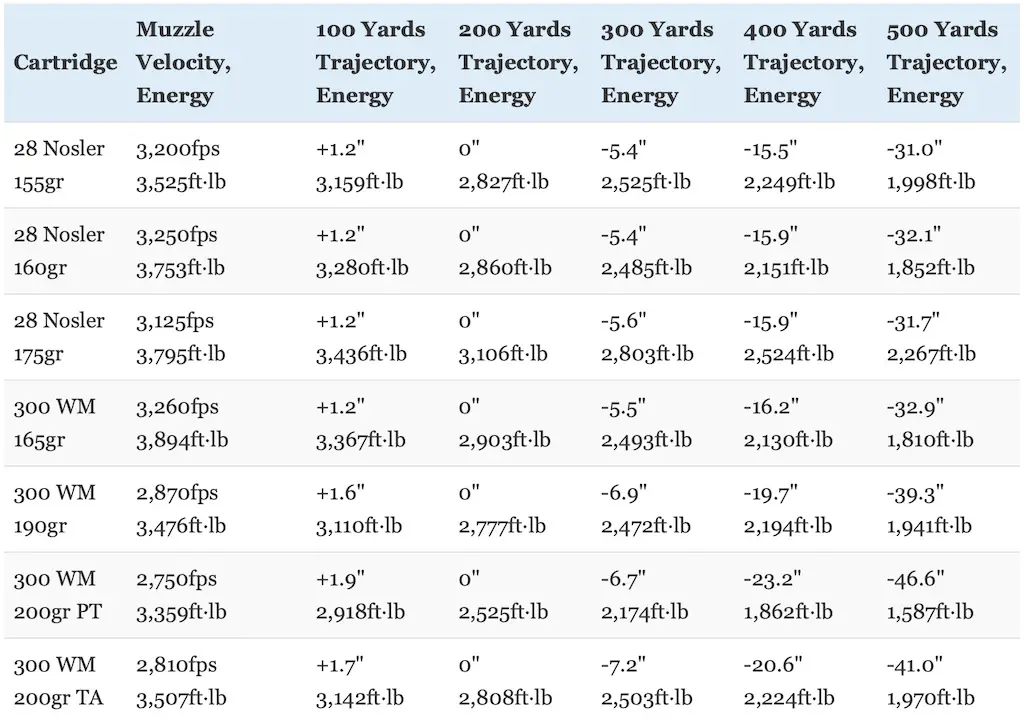
As you can see, the 28 Nosler has a flatter trajectory across the board.
Interestingly, all 3 28 Nosler loads have a very similar trajectory with about 1″ difference in bullet drop at 500 yards between them.
That high velocity 165gr 300 Win Mag load comes close though, with just .8-1.9″ (2.5-6.1%) of difference in bullet drop at 500 yards compared to the various 28 Nosler loads. However, that particular 300 Win Mag load is also starting to run out of steam due to the lower BC bullet it uses and has 2-20% less kinetic energy remaining than all of the 28 Nosler loads.
That particular 300 Win Mag load hangs tough with the 28 Nosler because they all have one characteristic in common: a high muzzle velocity in the 3,100-3,260fps range.
The other 300 Win Mag loads fire heavier bullets in the 2,750-2,870fps range.
Even though the 300 Win Mag loads used in this comparison (aside from the 165gr load) fire heavier bullets, their slower muzzle velocity results in a more arching trajectory and (for the most part) less kinetic energy at all ranges.
That 400-500fps difference in muzzle velocity is a BIG difference and the results are stark.
The 300 Win Mag load firing the 190gr AccuBond Long Range has the flattest trajectory of the 300 Win Mag loads, but still has 7.2″ (22.5%) more bullet drop at 500 yards than the most arching 28 Nosler load.
The results are similar when it comes to retained energy, with the fastest loads having the most muzzle energy. Depending on the exact bullet we’re comparing, that gap will either grow (like with the high BC 175gr AccBond Long Range for the 28 Nosler compared to everything) or potentially shrink slightly (like the 200gr Terminal Ascent and 190gr AccBond Long Range compared to the 160gr Partition).
That 175gr AccBond Long Range load from the 28 Nosler really stands apart from the crowd with by far the most retained energy remaining at 500 yards (13-22% more than the other 28 Nosler loads and 15-43% more than the 300 Win Mag loads) and very nearly the flattest trajectory (only eclipsed by the 155gr 28 Nosler Terminal Ascent load by less than 1″).
Heck, that 175gr 28 Nosler load carries over 3,000 ft-lbs of energy out past 200 yards!
The differences between these cartridges become even more apparent at longer range, which is illustrated in the table below for those same loads at 600-800 yards.
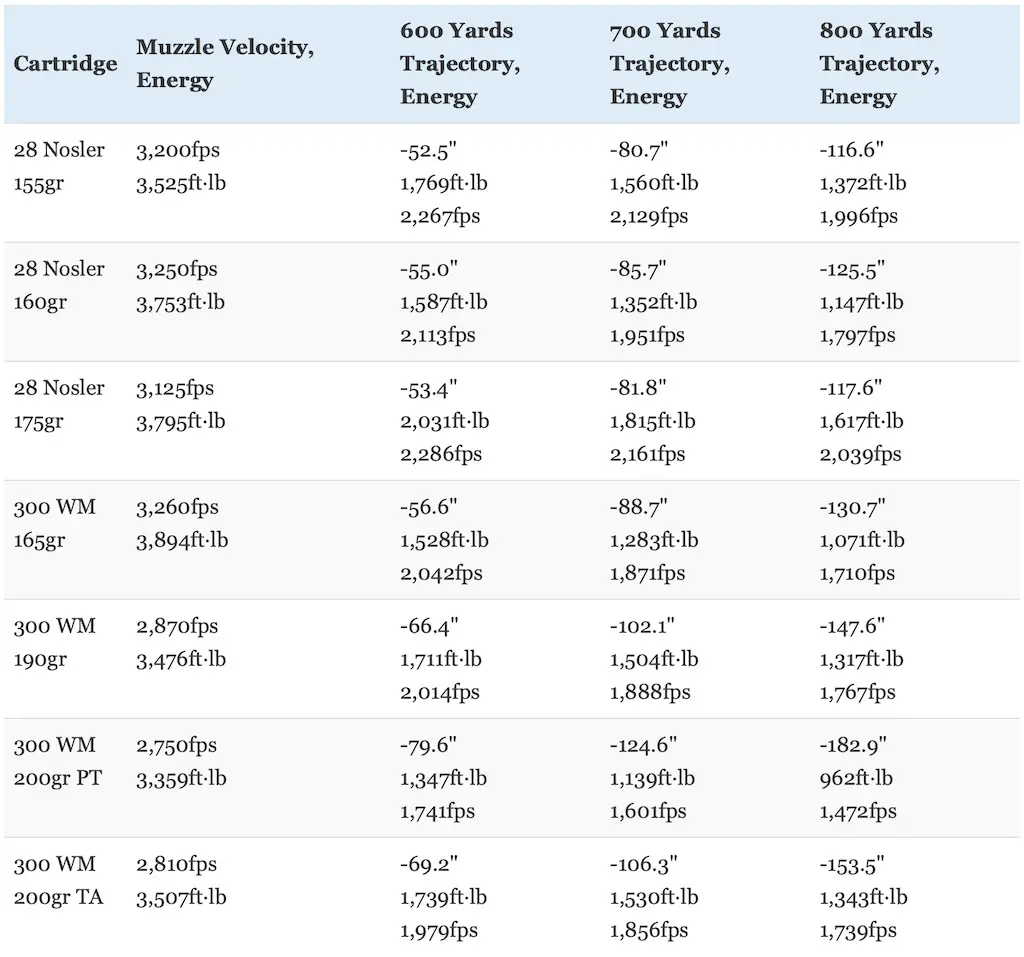
Now, I’m not saying that you should personally use either the 28 Nosler or 300 Win Mag for hunting at really long range. That’s a sensitive topic and very few people have the skill to ethically shoot a deer or an elk at extended range.
That said, this is an area where the 28 Nosler really starts to shine.
That 175gr AccuBond Long Range load in particular really sticks out as an outstanding choice at longer range.
First, with 1,617 ft-lbs of retained energy out at 800 yards, it’s the only load of the 7 that still surpasses the 1,500 ft-lbs of energy minimum many people consider a good rule of thumb for elk hunting.
Both Terminal Ascent loads and the 190gr AccuBond Long Range load for the 300 Win Mag come close, but dip below that threshold between 700 and 800 yards.
In that vein, look at how quickly the 165gr 300 Win Mag load (which started off so fast) continues to lose steam due to its lower BC.
Next, the kinetic energy advantage the 175gr 28 Nosler load has over the other 28 Nosler and 300 Win Mag loads gets even larger out at 800 yards: it has 18-41% more energy than the 28 Nosler loads and 20-68% more energy than the 300 Win Mag loads.
Next, while the 155gr Terminal Ascent load does have the flattest trajectory, 1″ of difference in bullet drop at 800 yards between that load and the 175gr AccuBond Long Range is absolutely miniscule. Otherwise, the 175gr AccuBond Long Range really stands apart from the rest of the crowd in terms of trajectory.
At the same time, the 28 Nosler Terminal Ascent load is neck and neck with the 300 Win Mag Terminal Ascent in terms of retained energy, but the 300 Win Mag load is going over 200fps slower and has more than 3 feet (37.5″) of additional bullet drop at 800 yards.
The 190gr 300 Win Mag AccuBond Long Range has a similar velocity and amount of kinetic energy compared to the 200gr 300 Win Mag Terminal Ascent, but the 300 Win Mag AccuBond Long Range has about 6″ less bullet drop at 800 yards.
However, the 28 Nosler AccuBond Long Range load is going over 250fps faster than the 300 Win Mag AccuBond Long Range, has 30″ less bullet drop, and has an additional 300ft-lbs of energy at 800 yards.
Additionally, don’t forget about the importance of impact velocity. At really long range there’s a real concern that some bullets won’t impact at a high enough velocity for reliable expansion.
As a rule of thumb, the Hornady CX needs 2,000fps of impact velocity, the Nosler Partition needs 1,800fps of impact velocity, and the Terminal Ascent and Nosler AccuBond Long Range each need 1,350fps of impact velocity for good expansion.
With that in mind, the 200gr Partition dips below 1,800fps between 500 and 600 yards, the 165gr CX is barely going fast enough to expand at 600 yards, and the 160gr Partition dips below 1,800fps just shy of 800 yards.
However, both AccuBond Long Range and Terminal Ascent bullets for the 300 Win Mag and 28 Nosler are all still going fast enough to expand past 800 yards.
Again: I’m not necessarily advocating long range hunting here. However, I think the 28 Nosler really offers a massive improvement over the 300 Win Mag in that area though.
The chart below compares how much a 10 mile per hour crosswind impacts those same 300 Win Mag and 28 Nosler loads out to 500 yards.
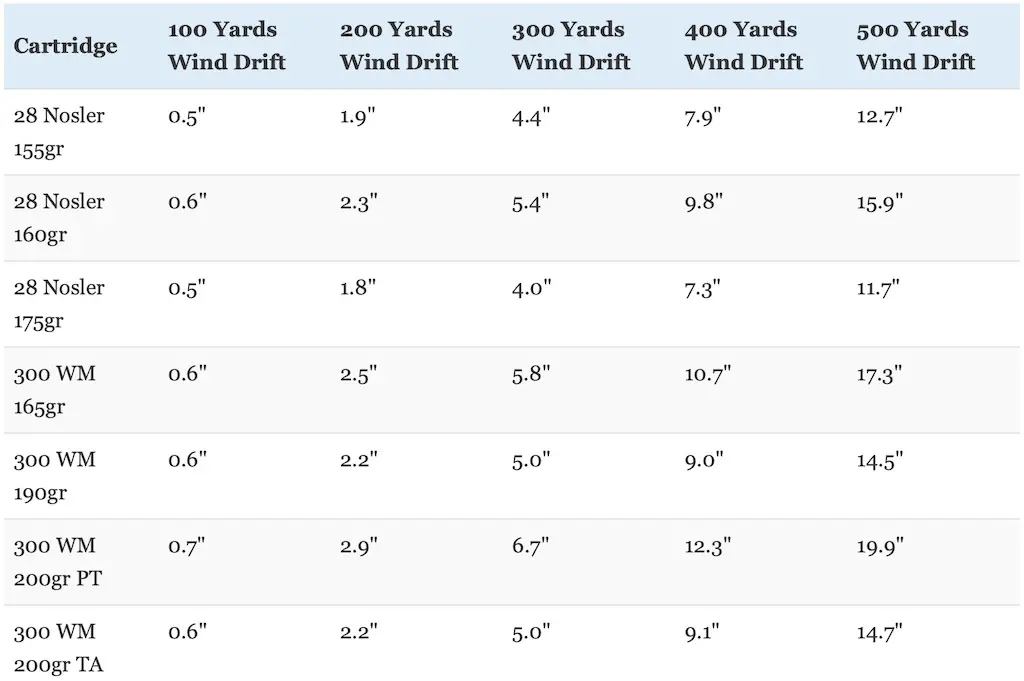
Similar to the situation we just discussed with trajectory and kinetic energy, the 28 Nosler has a definite edge over the 300 Win Mag in terms of wind deflection.
This is especially true with the high velocity/high BC 175gr AccuBond Long Range load for the 28 Nosler.
Additionally, note the lackluster performance of the 165gr 300 Win Mag here. It was hanging close to the 28 Nosler in terms of trajectory due to its high muzzle velocity, but the low BC of the bullet really hampers its performance in the wind.
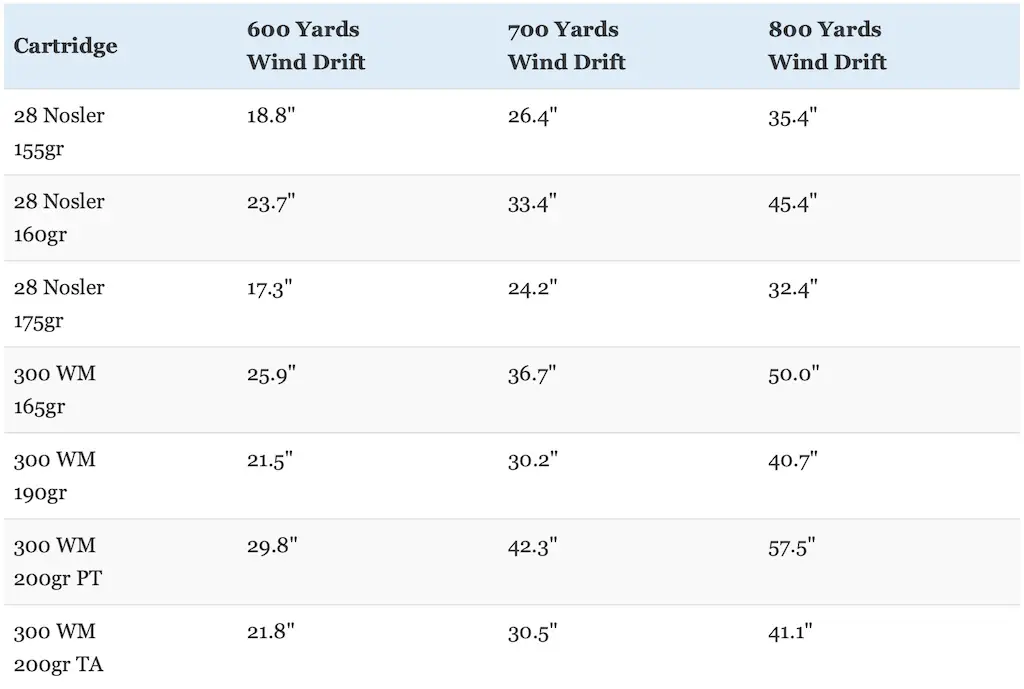
The differences between the cartridges in terms of wind deflection are even more pronounced at longer range.
It’s a whole lot easier to correct for bullet drop these days using a laser rangefinder and an adjustable scope turret than it is to estimate the correct wind direction and speed to calculate a wind hold.
Dealing with the wind is always tricky and it gets exponentially more difficult as range increases. For this reason, wind bucking cartridges like the 28 Nosler that help the shooter deal with wind estimation errors can absolutely help the shooter battle environmental conditions and result in better shot placement at longer range.
Well, the 175 grain AccuBond Long Range 28 Nosler load has only a little bit more wind drift at 800 yards than the two best 300 Win Mag loads have at 700 yards (the case is similar with the 28 Nosler Terminal Ascent).
With this in mind, which one would you rather be shooting at an animal at longer range if there’s any wind at all?
External ballistics don’t tell the whole story though and there’s more to picking a hunting cartridge than kinetic energy, bullet drop, or wind drift at various ranges.
Now let’s talk about recoil.
The table below compares the recoil produced by handloads that approximate the performance of the Nosler AccuBond Long Range loads above firing the 190gr and 175gr bullets for the 300 Win Mag and 28 Nosler respectively when fired from identical 7 pound rifles.
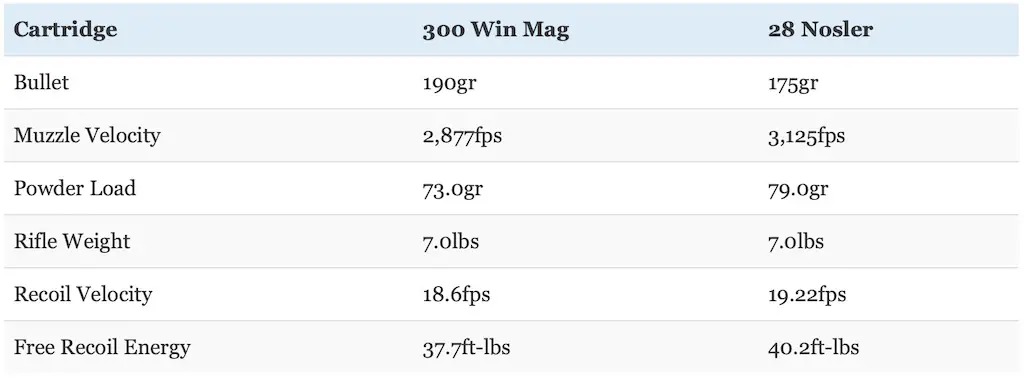
Felt recoil will vary from shooter to shooter and rifle to rifle, but free recoil energy is still a useful way to compare cartridges.
As you can see, the two cartridges both have fairly stout recoil, with the 28 Nosler having a little more than the 300 Win Mag with this particular loading.
It’s true that 175gr AccuBond Long Range load looks really good on paper for the 28 Nosler. However, that performance comes at the price of more recoil.
That load fires a little bit lighter bullet at a much faster velocity and uses a lot more powder to achieve that performance. The end result is that the 28 Nosler has about 6.6% more free recoil energy than the 300 Win Mag.
Now, even the 28 Nosler doesn’t have a ridiculous amount of recoil. The recoil produced by this particular load is getting up there and is certainly stout, but it’s also not so excessive that it’s impossible to shoot.
And it’s also close enough to 300 Win Mag recoil that a person who can handle the recoil of one should be able to handle the recoil of the other too.
Additionally, this recoil can be mitigated to a certain extent with the use of a suppressor, muzzle brake, or a good recoil pad. So the extra recoil of the 28 Nosler isn’t necessarily a deal breaker for many people.
It’s still worth considering though and this is a slight advantage in favor of the 300 Win Mag.
Don’t underestimate the impact that recoil has on the ability of a person to shoot accurately either. Some people do handle recoil better than others, but all other things being equal, they will absolutely shoot more accurately with a milder recoiling cartridge.
Additionally, there are a couple of other factors that are also worth discussing.
First, the 300 Win Mag uses larger diameter bullets than the 28 Nosler.
Specifically, the larger diameter .308″ bullets used by the .300 Win Mag have just over 17% more frontal surface area (also known as cross sectional area) than the .284″ bullets used by the 28 Nosler (.0745 vs .0633 square inches). All other things being equal, a bigger bullet will make a bigger hole, cause more tissue damage, and result in more blood loss.
This is another advantage in favor of the 300 Win Mag.
On the other hand, as we covered earlier, many of those longer, heavy for caliber .284″ bullets the 28 Nosler is optimized for have a higher ballistic coefficient than the most common bullets used in the 300 Win Mag, especially when bullet weights are similar.
That’s not a hard and fast rule though.
For instance, the .284″ 175gr AccuBond Long Range used by the 28 Nosler has a BC of .648. This is higher than the .308″ 190gr AccuBond Long Range (.597 BC) and the 200gr Terminal Ascent (.608).
At the same time, Hornady makes a 28 Nosler loading in their Precision Hunter line with a 162gr ELD-X (.631 BC) which is more aerodynamic than both 300 Win Mag loads in that same line with a 178gr ELD-X (.552 BC) and a 200gr ELD-X (.597 BC).
On the other hand, there’s a split decision with the 160gr 7mm Partition (.475 BC) having a tiny bit higher BC than the 180gr .30 caliber Partition (.474), but not the 200gr .30 caliber Partition (.481 BC).
And of course, the 200gr Terminal Ascent Load for the 300 Win Mag has a higher BC of .608 than the .586 BC of the 155gr Terminal Ascent loading for the 28 Nosler. Admittedly, that’s a pretty light for caliber bullet weight for the 28 Nosler though.
All things considered, the 28 Nosler does have an edge here with the heaviest for caliber loadings for that chambering (over 160 grains).
While those differences are indeed small in favor of the 28 Nosler, they are still worth considering because those slightly more aerodynamic projectiles don’t slow down as fast and are more resistant to wind drift.
What about 28 Nosler vs 300 Win Mag accuracy?
Both are certainly capable of outstanding accuracy (often sub-MOA) in the right hands and in good rifles.
It’s really hard to pick a winner here.
On one hand, the 28 Nosler in particular has great ballistics on paper, which can help the shooter battle environmental conditions and effectively place rounds on target.
On the other hand, while the on paper ballistic performance of the 300 Win Mag lags behind the 28 Nosler, but it also has less recoil.
Basically, the lower recoil of the 300 Win Mag can help facilitate better accuracy and help maximize the shooting abilities of the hunter using the cartridge to a greater degree than the 28 Nosler, but the 28 Nosler can help the shooter battle environmental conditions to a greater degree than the 300 Win Mag when appropriate loads are used.
In any case, the details will vary on the exact rifle, ammunition, and shooter in question. However, both cartridges certainly have excellent potential for accuracy.
I’d give the edge to the 300 Win Mag at shorter ranges and under less demanding environmental conditions and the advantage to the 28 Nosler at longer range and under more challenging environmental conditions.

300 Win Mag vs 28 Nosler Barrel Life
There can be a pretty big practical difference in 28 Nosler vs 300 Win Mag barrel life.
The 28 Nosler in particular has a reputation for being rough on barrels (though not quite to the extent of the 26 Nosler). This is because the 28 Nosler uses considerably more powder than the 300 Win Mag does in a smaller sized space.
This means that, in general, the 28 Nosler will simply wear out barrels faster than the 300 Win Mag. Exactly how fast that occurs depends on a number of factors like the quality of the barrel, the exact ammunition used, etc.
For serious target shooters, this can be a concern. However, it can still potentially be an issue for hunters as well if they do not exercise care. This is especially true for those who are using the 28 Nosler at longer range where smaller changes in performance and accuracy add up quickly.
The details will vary, but it’s not unheard of for some 28 Nosler rifles to see a drop off in accuracy after just a few hundred rounds. Others will last 800-1,000 rounds, but it’s unusual to hear of them lasting much longer than that with full powered ammunition.
The good news for hunters is that typical barrel life for even the 28 Nosler is more than enough to last for many years of hunting with no issues. Exactly when the barrel is unusable depends on the rifle as well as the hunter in question and what sort of performance they expect from their rifle.
Those who want extremely tight groups for long range shooting are probably going to want to change their barrel out sooner than those with slightly lower standards.
All other things being equal, the 300 Win Mag will probably have better barrel life than the 28 Nosler.
So where do we stand with each cartridge?
28 Nosler vs 300 Win Mag
The 28 Nosler fires a smaller diameter, lighter, and often more aerodynamic bullet at a significantly faster velocity than the 300 Win Mag. The 28 Nosler has more recoil, a flatter trajectory, more resistance to wind drift, and carries significantly more retained kinetic energy downrange than the 300 Win Mag.
28 Nosler vs 300 Win Mag Ammo
Of the two, the 300 Win Mag is definitely the more popular and it’s usually among the top 10 most popular cartridges in the USA each year. The 28 Nosler is not quite as common or as popular as the 300 Win Mag, but it’s by no means rare either.
The big ammunition manufacturers like Barnes, Berger, Browning, Federal Premium, Hornady, HSM, Nosler, Remington, Sierra, Sig Sauer, Swift, and Winchester produce an incredible variety of .300 Winchester Magnum factory ammunition. In that vein, there is normally a good selection of bullet types and weights for the cartridge suitable for big game hunting.
As of late 2022, there are only a handful of 28 Nosler hunting ammo loadings though.
First, it’s available in the Federal Terminal Ascent line loaded with a 155gr Terminal Ascent bullet and the Hornady Precision Hunter line loaded with 162gr ELD-X bullet.
Browning now produces 28 Nosler ammo in their BXS line with a 139 grain Solid Copper and in their BXC line with a 155 grain Terminal Tip.
Finally, Nosler produces 28 Nosler ammo in the Nosler Trophy Grade line loaded with a 160gr AccuBond Bullet, the Nosler Trophy Grade Partition line with a 160gr Partition bullet, the Nosler E-Tip line loaded with a 150gr E-Tip bullet, the Nosler Ballistic Tip Line with a 160 grain Ballistic Tip bullet, and the Nosler Trophy Grade Long Range line loaded with a 175gr AccuBond Long Range bullet.
During normal times, it’s usually not too hard to find ammo for both cartridges (but especially the 300 Win Mag). Almost any gun or sporting goods store will have a wide variety of .300 Winchester Magnum ammo in stock. However, the 28 Nosler is a more niche cartridge and you’ll probably need to go to a larger or more specialized store to find 28 Nosler ammo in stock as many smaller retailers and local stores won’t carry it.
At the same time, 300 Win Mag ammo is typically noticeably cheaper than 28 Nosler ammo.
Ammo availability is also usually decent online and the bigger retailers typically have a good selection of quality factory ammo for both cartridges as well (but the 300 Win Mag will likely still be easier to find and less expensive, even online).
Bottom line: the average hunter will have easier access to ammo at cheaper prices for the 300 Win Mag than the 28 Nosler.
BUY SOME GREAT 28 NOSLER AMMO HERE
BUY SOME EXCELLENT 300 WIN MAG AMMO HERE
If you’d like to learn more about some of the various hunting ammunition choices for the 28 Nosler and 300 Win Mag, read these articles:
Best 28 Nosler Ammo For Hunting Elk and Deer
Best 300 Win Mag Ammo For Hunting Deer, Elk, And Other Game
Handloaders will appreciate the fact that reloading components for both cartridges are widely available and there’s an excellent variety of bullet choices for each cartridge. So, you should not have any trouble working up a good custom load for either one if you like to handload.
The 28 Nosler uses the same 7mm/.284″ bullet size as other 7mm cartridges like the 7mm-08 Remington, 7mm Mauser, 280 Ackley Improved, 7mm STW, 7mm WSM, 7 mm Rem Mag and 7mm SAUM (among others).
The 300 Win Mag uses the same 308″ bullet size as the .308 Winchester, .30-30 Winchester, .30-06 Springfield, 300 WSM, .300 Ultra Mag, and .300 PRC.
300 Win Mag vs 28 Nosler Rifles
The rifle situation with the 300 Winchester Magnum and 28 Nosler is similar to the ammunition situation.
Of the 2, the 300 Winchester Magnum is the most popular and is available in several different versions of the Remington Model 700 and Winchester Model 70. The same goes for the Browning X-Bolt, Browning AB3, Christensen Arms Ridgeline, Kimber Hunter, Mossberg Patriot, Ruger Hawkeye, Savage Axis, Savage 110, Tikka T3 and Tikka T3x, Weatherby Vanguard, and Winchester XPR.
Basically, almost every popular centerfire rifle in current production is available in 300 Winchester Magnum.
Things are a little different with the 28 Nosler though, which is primarily available in higher end rifles that are best able to take advantage of the long range performance characteristics of the cartridge.
The 28 Nosler is available in rifles like the Christensen Arms Mesa, Ridgeline, and ELR rifle, several different versions of the Browning X-Bolt, several different rifles from Bergara, from Gunwerks, and from Seekins Precision.
Of course, Nosler also offers the 28 Nosler in their M48 rifle and their new M21 rifles (which are both also available in 300 Win Mag).
During normal times, the 300 Winchester Magnum is the most common and easiest to find. The same goes with finding 300 Win Mag rifles that are less expensive.
However, as of late 2022, we’re still not living in normal times.
I realize the situation may be different where you live and has likely varied over the past two years, but as I write this article in September of 2022, 300 Winchester Magnum rifles are more common on dealer’s shelves than 28 Nosler rifles (at least where I live).
It’s also important to realize that gun manufacturers tend to put longer barrels on rifles chambered in magnum cartridges in general. This is because those cartridges need a longer barrel to effectively and efficiently burn that larger powder charge.
This holds true for both the 300 Winchester Magnum and the 28 Nosler.
Barrel lengths do vary depending on the manufacturer and exact model, but 24″ and even 26″ barrels are pretty standard with the 300 Winchester Magnum.
The 28 Nosler is most common in rifles with a 26″ barrel though.
While the two cartridges are often available in rifles of the same size and length, other rifles chambered in 28 Nosler may be slightly longer, heavier, and more unwieldy than rifles chambered in 300 Win Mag.
Having a shorter and lighter rifle is more important on some hunts than on others. So, just keep that in mind.
BUY A GREAT 28 NOSLER RIFLE HERE
BUY A GREAT 300 WIN MAG RIFLE HERE
If you’d like to learn more about some of the various hunting rifle choices for the 300 Winchester Magnum cartridge, read this article:
Best 300 Win Mag Hunting Rifles
28 Nosler vs 300 Win Mag: Which Is Right For You?
Do you primarily hunt medium sized game like whitetail deer, feral hogs, or black bear at ranges within 200 yards? Both are extremely effective deer hunting cartridges and will absolutely get the job done on medium sized game if you do your part. There’s nothing wrong with using either cartridge on deer inside of 200 yards, but both are really more gun than you need for that sort of work though.
The 28 Nosler in particular will be harder on both your shoulder and your wallet than the 300 Win Mag as well.
If you’re going to be hunting in thick brush or in the tight confines of a deer stand, remember what I just mentioned about the barrel length difference with 28 Nosler vs 300 Win Mag rifles. That extra couple of inches in overall length of a rifle can be a real headache to deal with when trying to quickly and quietly maneuver for a shot. Neither are really good options for a truly compact rifle, but a 300 Win Mag with a 24″ barrel will be a little easier to handle than a 28 Nosler rifle with a 26″ barrel.
Are you looking for the cartridge better suited for long range hunting for game like mule deer or pronghorn antelope in open country where you might need to take a shot at several hundred yards? Once again, they’ll both work really well in this role and situations like these are where they start to stand apart from other cartridges. The 28 Nosler carries more energy out to extended range than the 300 Win Mag, but the 300 Win Mag is still a really good choice for this role as well and many loads carry more than 1,500 ft-lbs of energy out past 500 yards.
Do you want a hunting cartridge that’s well suited for caribou, moose, elk, eland, kudu, or red stag hunting? Both work extremely well when used on bigger game in North America, Africa, Europe, and elsewhere. If we’re being honest with ourselves here, the 300 Win Mag is by far the more popular elk hunting cartridge and has taken way more elk than the 28 Nosler over the years, primarily due to the fact that it’s been around so much longer.
Most hunters do not need the capabilities of the 28 Nosler and something like the 300 Win Mag will work great for the majority of elk hunting situations. I personally don’t feel comfortable shooting game out past about 450 yards myself and the 300 Win Mag performs great out that far (and even a little farther in the right hands) on really big game like elk and moose.
However, a person with the right shooting skills who wanted to extend their effective range by a another couple hundred yards would be well served by the 28 Nosler. The 28 Nosler is the clear winner for a hunter looking for a really good cartridge for use on bigger game, especially at extended range.
Remember: there are certain 28 Nosler loads that have an additional 300-400ft-lbs of kinetic energy than comparable 300 Win Mag loads out at several hundred yards. The 28 Nosler with that 175gr AccuBond Long Range load is absolutely a better choice for those who want the most power, the flattest trajectory, and the most resistance to wind at longer ranges.
Are you specifically hunting brown or grizzly bear? What if you hunt in Canada or Alaska and need a heavy hitting cartridge just in case you find yourself on the wrong end of a grizzly/brown bear attack? I do not recommend either of these cartridges for actually hunting the big bears (or other species of dangerous game like cape buffalo), though they will work on the big bears in a pinch. While I’d prefer to carry something heavier like a .338 Win Mag (or a 375 H&H) in grizzly country, I’d go with the 300 Win Mag over the 28 Nosler since it uses larger diameter and heavier bullets. Make sure you use premium, heavy for caliber 180gr, 190gr, or (ideally) 200gr bullets if you go that route.
Are you sensitive to recoil and in need of a serious low recoil cartridge? Both cartridges have fairly stout recoil, but the 300 Win Mag is definitely a better lower recoiling option than the 28 Nosler. You should consider stepping down farther to something like the 6.8 Western or 7mm Rem Mag if you want magnum performance with even less recoil though.
The 300 Win Mag and 28 Nosler are both excellent rifle cartridges. While the 28 Nosler is a newer and more specialized cartridge that does offer certain advantages over the 300 Win Mag in some aspects, few hunters really need the extra capability offered by the cartridge and there’s still not a darn thing wrong with the 300 Win Mag either.
Though the differences between them (28 Nosler vs 300 Win Mag) are fairly significant in certain respects, they’re all suitable for many hunting tasks.
So, carefully analyze your potential needs before making a decision. In the end, a lot of this decision comes down to personal preference, the exact game you’re after, and the conditions of your hunt. So, choose the one that you feel most comfortable with and it will probably serve you well afield. Good luck!
NEXT: 308 vs 30-06 SPRINGFIELD vs 300 WIN MAG: WHICH SHOULD YOU HUNT WITH?
NEXT: BEST GIFTS FOR HUNTERS
Enjoy this article comparing the 300 Winchester Magnum and 28 Nosler cartridges? Please share it with your friends on Facebook and Twitter.
The Lyman 50th Edition (p223-224 & p260-262) and Hornady 10th Edition (p574-585) reloading manuals were used as references for the history of the 28 Nosler vs 300 Win Mag cartridges. I obtained the data used to compare the trajectory of the cartridges from Hornady (here), Federal (here and here), and Nosler (here, here, here, and here). Data used to calculate recoil was obtained from the Nosler 9th edition reloading manual (p449 & p547). Case capacity information for the 300 Win Mag and 28 Nosler was obtained from Chuck Hawks and Nosler. Maximum pressure and data to compare cartridge sizes for the 28 Nosler and 300 Win Mag were obtained from SAAMI (p28, p30, p87, and p105). I used ShootersCalculator.com to compare trajectory and recoil for the cartridges.
Make sure you subscribe to The Big Game Hunting Podcast and follow The Big Game Hunting Blog on Facebook, Instagram, Twitter, and YouTube.
John McAdams is a proficient blogger, experienced shooter, and long time hunter who has pursued big game in 8 different countries on 3 separate continents. John graduated from the United States Military Academy at West Point and is a veteran of combat tours with the US Army in Iraq & Afghanistan. In addition to founding and writing for The Big Game Hunting Blog, John has written for outdoor publications like Bear Hunting Magazine, The Texas State Rifle Association newsletter, Texas Wildlife Magazine, & Wide Open Spaces. Learn more about John here, read some of John’s most popular articles, and be sure to subscribe to his show: the Big Game Hunting Podcast.


Great comparison! It’s interesting to see how the 28 Nosler stacks up against the 300 Win Mag in terms of performance and versatility. I’ve been considering a new rifle and this helped clarify some of my options. Thanks for the detailed breakdown!